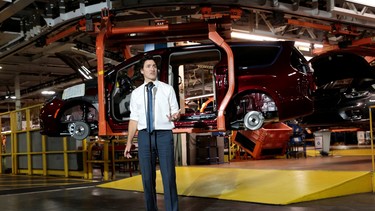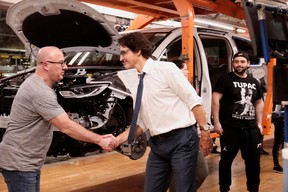Why VW got $13 billion from the fed for its new battery plant in St. Thomas, and why Stellantis thinks it deserves the same

Article content
The headlines have been ominous. The CBC says the “government and Stellantis [are] playing [a] ‘high-stakes game’ with Windsor EV battery plant.” Other outlets have Ottawa “reneging” on its Windsor EV plant deal. Stellantis has even publicly said the “Canadian government has not delivered on what was agreed to” and that it might have to start “implementing contingency plans.” Said contingency plans may not have been specified, but, if you’re thinking the company is saying it might move its proposed battery plant from Ontario to the United States, you would not be alone.
Advertisement 2
Article content
So what gives? How did a deal, greeted with so much fanfare barely a year ago, turn into such a shit-show? What are the issues, and are there solutions? For all — okay, some — of the answers, Motor Mouth will try to decipher this tempest-in-a-battery-plant. And, as with all such stories, the most important thing is to—
Follow the money
This controversy is all about money. More specifically, the absolutely astonishing amount of greenbacks the American Inflation Reduction Act (IRA) promises to automakers; and Canada’s (somewhat belated) attempt to match it. Indeed, by now, pretty much every sentient Canadian — at least sentient Canadians reading Driving — knows that Volkswagen scored $13 billion dollars to build a battery manufacturing plant in St. Thomas, Ontario. Almost as common is the knowledge that the reason Stellantis is so pissed is that it didn’t receive nearly the same windfall to build its plant in Windsor (its take is said to be in the neighbourhood of $500 million).
Advertisement 3
Article content
But that’s about it for common knowledge. Indeed, there is a bounty of misinformation regarding why all these monies are being offered, and where they come from. First among those mis-directions are all the news reports detailing how automakers’ — and their home country’s politicians’ — ire is centred on the IRA’s promise of a generous US$7,500 consumer incentive, officially outlined in the bill’s 30D clauses.
-
![Motor Mouth: The ‘EV frenzy’ of battery manufacturing is passing Canada by]()
Motor Mouth: The ‘EV frenzy’ of battery manufacturing is passing Canada by
-
![Motor Mouth: A quarter-million jobs may be at stake for Canada’s auto industry]()
Motor Mouth: A quarter-million jobs may be at stake for Canada’s auto industry
Nope, that’s not the problem at all. The real story is hidden deeper in the bowels of the IRA, specifically section 45X. Aimed at countering China’s expansive lead in battery manufacturing, it promises any automaker or affiliate that builds a battery manufacturing plant a federal credit of US$45 per kilowatt-hour (kWh) it manufactures, but only if said plant is in the United States. Not in Canada or Mexico – the above-mentioned US$7,500 consumer incentive still applies to cars built in those countries – but only in the U.S.A.
Advertisement 4
Article content
More importantly, this is not a one-time deal, like the grants desperate politicians typically offer to automakers to build an assembly plant in their jurisdiction. Instead, that US$45 for every kWh produced is being offered as an ongoing bonus, payable from the time the plant starts producing batteries; until 2032, when the program runs its course.
As Motor Mouth outlined way back in October 2022, that means that a typical 45-gigawatt factory — if built on American soil and meeting all of the IRA’s guidelines — would be eligible for incentives of US$2 billion each and every year until 2032. So, if you’ve been wondering how the feds and Volkswagen arrived at that CDN$13 billion number the company is supposed to receive from Canadian taxpayers, it’s simply the Canadian government matching the roughly US$10 billion the company would have received between the start of production and IRA program end, had that same plant been built south of the 49th parallel.
Advertisement 5
Article content

Follow the money some more
The amount of blarney surrounding this story is truly worthy of the politicians spinning it. The one estimate that would, however, appear to be believable is that the Stellantis-LG plant will generate 2,500 new jobs. After that, well, the spin starts to get truly outlandish.
For instance, according to reports, some politicians think the Windsor plant will generate 25,000 new jobs, or that 25,000 existing jobs will be saved. They arrive at that figure by factoring in 10 new ancillary jobs for every primary new employment opening at the battery plant. That’s not quite double the estimate that the Trillium Network for Advanced Manufacturing – the analysts who have done the best job of analyzing the auto industry and the effect of battery manufacturing on Canadian employment – would be reasonable to presume. But nonetheless, just for giggle’s sake, let’s go with 25,000 jobs.
Advertisement 6
Article content
Splitting $13 billion some 25,000 ways works out to $520,000. That’s how much every one of those jobs will cost. At an annual salary of $80,000 per job — and that would seem somewhat extravagant, since not all the jobs will be unionized — we could have paid all 25,000 of those people full salary just to stay home for six-and-a-half years.
If you’ve been wondering how the feds and VW arrived at CDN$13 billion, it’s simply the Canadian government matching the roughly US$10 billion the company would have received
But that’s just standard populist bafflegab served to rile up the Poilievre crowd. More telling, however, is how much tax revenue those jobs must generate to pay back that $13 billion. Using my handy-dandy tax calculator — taxtips.ca, a program that emulates Revenue Canada calculations — each of those jobs would generate a little less than $16,000 dollars in tax, provincial and federal combined. In other words, those 25,000 workers would have to work more than 30 years for their tax revenues to repay the monies Trudeau’s Liberals are so generously doling out.
Advertisement 7
Article content
Of course, that doesn’t account for the various corporate taxes that will fill Ottawa’s coffers over that same time frame. However, even if various business revenues account for two-thirds of the tax haul that will be generated by all those jobs, that still leaves a 10-year payback period. And that’s with a hyper-inflated estimation it’ll generate 25,000 jobs; if you use a more realistic number for job creation — say, 15,000 — the numbers look even worse.
However many jobs are involved, and whatever the actual split between corporate and personal tax revenues might be, we’re looking at a truly extended payback period. At today’s interest rates, I‘m pretty sure I could find any number of actuaries who would suggest that paying down our federal debt by $13 billion — or, actually, not taking on new debt — would be a better investment.
Advertisement 8
Article content
Read the bottom line

Grotesque amounts of money aside, there’s more than a normal amount of politicking going on here. Without having access to any of the final agreements the government signed with both car companies, any interpretation of what Stellantis is after is pure conjecture.
What we do know, however, is that Stellantis signed its agreement with the Ontario and federal governments to build its battery-manufacturing plant in Windsor in March 2022, while the IRA was only signed in August of last year. How much of these negotiations are — totally justified — sour grapes, and how much is really the federal government not meeting commitments it previously made? That’s impossible to know, but it does raise one final, very important, question.
Advertisement 9
Article content
Does the U.S. government still consider Stellantis ‘American?’

One of the persistent rumours surrounding the Inflation Reduction Act is that America’s domestic automakers had a heads-up regarding — or perhaps even they were consulted on — its enormous subsidies. That would hardly be surprising, since the one thing pretty much everyone can agree on is that the IRA has nothing to do with reducing inflation, and everything to do with protecting American autoworkers.
If this scuttlebutt holds any water, then, it begs the question of why Stellantis would sign an accord with Canadian governments when it knew bigger money — waaay bigger money — was right across the border. The company was created, you’ll remember, in 2021, with the merger of Fiat-Chrysler and France’s PSA Group, and its stocks are listed on the Euronext exchanges in Paris and Milan, as well as New York’s NYSE. Is it possible that Stellantis had no idea of the monies that could come its way if it built its battery plant in the good ol’ U.S. of A, while Ford and General Motors did?
Or is Stellantis actually claiming it did have full knowledge of how much was promised in the IRA, and that the Canadian government made Volkswagen-like promises that have yet to be fulfilled? Who knows? But, when you’re talking billions of dollars to be paid out each and every year all the way to 2032, the politicking, it would seem, gets way more protracted.
Stay connected with us on social media platform for instant update click here to join our Twitter, & Facebook
We are now on Telegram. Click here to join our channel (@TechiUpdate) and stay updated with the latest Technology headlines.
For all the latest Automobiles News Click Here









Comments
Postmedia is committed to maintaining a lively but civil forum for discussion and encourage all readers to share their views on our articles. Comments may take up to an hour for moderation before appearing on the site. We ask you to keep your comments relevant and respectful. We have enabled email notifications—you will now receive an email if you receive a reply to your comment, there is an update to a comment thread you follow or if a user you follow comments. Visit our Community Guidelines for more information and details on how to adjust your email settings.
Join the Conversation